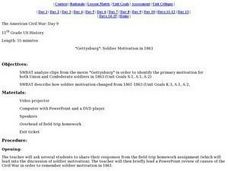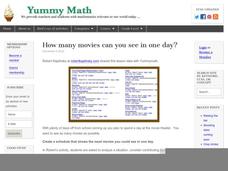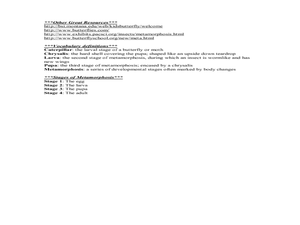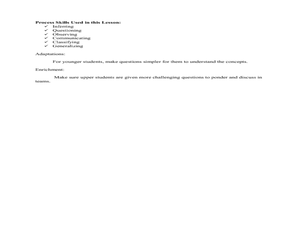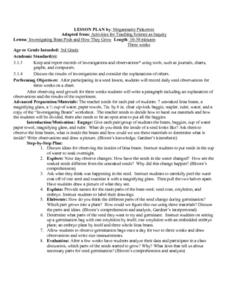Curated OER
"Gettysburg": Soldier Motivation in 1863
Eleventh graders watch and discuss various clips from the movie "Gettysburg". Using the video, they identify the main motivation for the Union and Confederate soldiers. They describe how soldiers motivation changed from 1861 and 1863.
Curated OER
Articles of Confederation Game
Why did the Articles of Confederation fail? Your historians will find out firsthand through this simulation activity, during which they will use money (consider using extra credit) to demonstrate the inherent flaws. It's simple: each...
Curated OER
Eco-Healthy Lunch
Students plan healthy lunches and how to dispose of their lunch waste. In this pre-field trip lesson plan, students and teachers plan healthy, nutritious lunches to bring on a field trip. They also discuss how to sort their garbage into...
Curated OER
Bubble-ology and Bernoulli
Students explore aerodynamics and Bernoulli's principle by devising ways to keep bubbles aloft.
Curated OER
Rocks and Minerals
Review the difference between rocks and minerals using this resource. Learners identify and investigate the physical properties of these objects. They create a Venn diagram to compare and contrast types of rocks. This is a motivating way...
American Statistical Association
A Sweet Task
Candy is always an effective motivator! A fun math activity uses M&M's and Skittles to explore two-way frequency tables and conditional probability. The candy can serve a dual purpose as manipulatives and experimental data.
Curated OER
The Male Reproductive System
Students identify the parts of the male reproductive system. They explore the functions of the male reproductive system. Students demonstrate the connection between reproductive health and the ability to reproduce. Students prepare...
Curated OER
How many movies can you see in one day?
For kids who love movies, figuring out a schedule for the maximum number that can be seen in one day is not only a good demonstration of Common Core mathematical practices, but also a highly motivating activity. Robert Kaplinsky...
Curated OER
Magnetic Mystery
Fourth graders investigate the poles of a magnet. In this magnet lesson, 4th graders explore what a magnet attracts and what it repels. Students view the N and S on magnets. students recognize that like poles repel and opposite...
Curated OER
The Physics of Sound: How We Produce Sounds
First graders construct a KWL chart on sound. For this physics lesson, 1st graders describe different ways to produce sound. They explain how sound waves propagate.
Curated OER
Life Cycle of the Monarch Butterfly
Third graders access prior knowledge of the monarch butterfly and discuss what they would like to know. In this Monarch Butterfly lesson,students read Monarch Butterfly and discuss the life cycle of the butterfly. Students gather...
Curated OER
The Physics of Sound: How We Produce Sounds
Young scholars are introduced to how they produce sounds. In groups, they participate in experiments in which they measure sound and identify their five senses. Individually, they make their own musical instruments using different...
Curated OER
Go Cough Up a Lung!
Third graders examine and identify the effects smoking has on the lungs. They view and discuss pictures of a smoker's lung and a healthy lung, and read and discuss an informational handout. Students then participate in an aerobic...
Curated OER
Indianapolis 500 Unit-Science
Fourth graders access prior knowledge of simple machines to build a car. In this car design lesson, 4th graders create and race their cars. Students evaluate what was good and bad about their designs. Each car will incorporate a...
Curated OER
A Day on the Farm
First graders, with a collection of various art supplies, plant a seed to observe it growing and record specific data on a data record sheet. They create a collage from various magazines of ten different foods farm animals eat and make a...
Curated OER
Jackie Gore
Students identify the amount of heat given off by solar energy. In this solar energy lesson, students complete an experiment using soil and sand measuring the heat from solar energy.
Curated OER
What's Your Favorite Planet?
Fourth graders, after listing the nine planets and their differences, choose one planet as their favorite. From the information acquired on each students favorite planet, they make a graph illustrating their favorites and then transform...
Curated OER
Conic Sections
Learners explore the different properties of conics. In this algebra lesson plan, students calculate the midpoint of a line, the distances between two points as they get ready to find the focus and directrix in eclipse and other conics....
Curated OER
Heat Energy
Young scholars study how matter changes from solids to liquids or liquids to solids. In this physical science lesson, students discuss heat energy and experiment with heat by changing a candle into a liquid using a hot plate.
Curated OER
Sense of Taste
Students swab different sections of the tongue to identify taste buds. In this sense of taste instructional activity, students make predictions and conduct an experiment. Students experiment with a variety of flavors and...
Curated OER
Slopes and Slope Intercepts
Young scholars identify the slope of an equation using various methods. In this algebra lesson, students graph linear equations and calculate the slopes using the x and y intercept to solve the equations and graph the lines. They use the...
Curated OER
Transformation, Reflections, Rotations and Translations
Students create a quilt, using different patterns. In this geometry lesson, students apply prior knowledge as they use different patterns to help them create a quilt using transformations and geometric shapes.
Curated OER
Sheep in the Field
Second graders create a three-dimensional picture of a sheep after observing a variety of templates of sheep. They then verbally identify the texture and color of the sheep. Students also read a book about sheep such as, "Sheep in a...
Curated OER
Investigating Bean Pods and How They Grow
Third graders observe and create a record of seed growth over time. After planting a seed, 3rd graders record their observations of the seed's growth over a three week period. Upon conclusion of the experiment, they write a paragraph...
